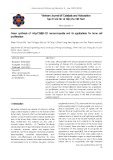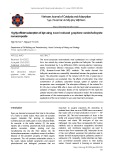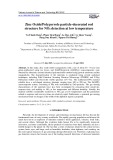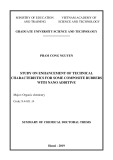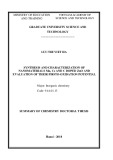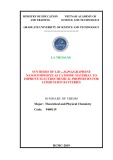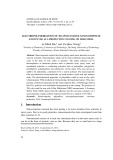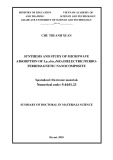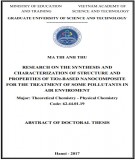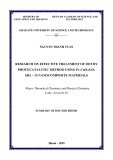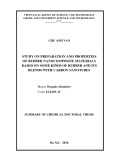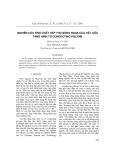
Nanocomposite material
-
In this study, nHAp/CS@β–CD–E nanocomposite has been synthesized by incorporating of chitosan (CS), β-cyclodextrin (β-CD), and Ficus pumila (L.) leaf extract with nano-hydroxyapatite (nHAp) via coprecipitation method. Meanwhile, the nHAp obtained from seashells as the starting material sources.
 6p
6p  vikwong
vikwong
 29-09-2024
29-09-2024
 5
5
 1
1
 Download
Download
-
The novel composite nanomaterials were synthesized via a simple method from two natural clay mineral sources, graphite and halloysite. The materials were characterized by X-ray diffraction (XRD), scanning electron microscopy (SEM), transmission electron microscopy (TEM), Fourier transform infrared (FTIR), Brunauer-Emmet-Teller (BET) methods.
 10p
10p  vikwong
vikwong
 29-09-2024
29-09-2024
 1
1
 1
1
 Download
Download
-
In this study, Zinc oxide (ZnO) nanoparticles with a size of about 50 - 70 nm were green-synthesized using tea leaves and ZnO/Polypyrrole (ZnO/Ppy) nanocomposites were obtained by ultrasonic-assisted chemical polymerization method using pyrrole monomer and the nanoparticles. The characterization of the materials is conducted using several analytical techniques, including Field Emission Scanning Electron Microscopy (FESEM) and X-Ray Diffraction (XRD) and Ultraviolet visible spectrum (UV-Vis).
 11p
11p  xuanphongdacy06
xuanphongdacy06
 18-09-2024
18-09-2024
 2
2
 1
1
 Download
Download
-
The objective of the research is to evaluate combination ability of nano additive with carbon black reinforced for rubber and rubber blend; create rubber nanocomposite materials with a high quality, solvent durability and sustainability in the naturally humid environment.
 27p
27p  capheviahe27
capheviahe27
 23-02-2021
23-02-2021
 27
27
 3
3
 Download
Download
-
Successful fabrication of polymer nanocomposite on the basis of PA6, PC thermoplastics, and CNT reinforcement to effectively apply the material system to the production of body protection equipment for the army forces.
 28p
28p  capheviahe27
capheviahe27
 23-02-2021
23-02-2021
 15
15
 2
2
 Download
Download
-
The thesis focused on the synthesis of Mn, Ce, C doped ZnO nanoparticles materials and doped ZnO with multi-layered carbon nanotube nanocomposite materials and assessed their photo-oxidative potentiality through photocatalytic reactions of methylene blue (MB) decomposition in aqueous solution under visible light.
 30p
30p  capheviahe27
capheviahe27
 23-02-2021
23-02-2021
 20
20
 5
5
 Download
Download
-
Nanocomposite material LiFe1-xMxPO4/Gr was successfully synthesized achieving it with single phase. It’s response required electrochemical parameters of positive electrode materials for Li-ion batteries such as: improved diffusion coefficient and conductivity, higher capacity comparative with LFP in same conditional synthesis.
 28p
28p  capheviahe26
capheviahe26
 25-01-2021
25-01-2021
 21
21
 3
3
 Download
Download
-
Find the optimal technology parameters and components for fabricating Fe-based nanomaterials using high-energy ball milling method; clarify the relationship between technological conditions with the structural characteristics and magnetic properties of fabricated materials; assess the applicability of Fe, Fe-Co nano materials in fabricating nanocomposite magnets and magnetic induction heating.
 24p
24p  capheviahe26
capheviahe26
 25-01-2021
25-01-2021
 19
19
 2
2
 Download
Download
-
In this study, TiO2 was used as an additive for polyaniline, considered to be a matrix polymer. The nanocomposite film was fabricated electrochemically on metal surfaces (mild steel and stainless steel). The electrochemical properties of polyaniline could be seen on the cyclic voltammogram.
 8p
8p  tamynhan8
tamynhan8
 04-11-2020
04-11-2020
 11
11
 3
3
 Download
Download
-
The objectives of the thesis: The thesis focused on the synthesis of Mn, Ce, C doped ZnO nanoparticles materials and doped ZnO with multi-layered carbon nanotube nanocomposite materials and assessed their photo-oxidative potentiality through photocatalytic reactions of methylene blue (MB) decomposition in aqueous solution under visible light.
 30p
30p  phongtitriet000
phongtitriet000
 08-08-2019
08-08-2019
 44
44
 4
4
 Download
Download
-
The thesis aims to produce nanoparticles (dielectric, ferrites, ferromagnetic, metal) and their nanoparticles. Find the optimal technology process, suitable for making absorbent samples. Survey the basic properties of fabricated nanomaterials. Measuring and studying the effects of microwave absorption in magnetic-dielectric nanoparticles, absorption mechanisms and dependence of absorbing properties on the parameters of materials, thereby finding solutions Enhance absorption capacity as well as adjust absorption parameters.
 28p
28p  xacxuoc4321
xacxuoc4321
 09-07-2019
09-07-2019
 29
29
 4
4
 Download
Download
-
The objective of the thesis is to produce two types of phase-phase Nano TiO2 materials Nitrogen inclusion on aluminum oxide metal (N-TiO2 / Al2O3) applied as a filter for air purifiers and nanocomposit hydroxyl apatite coated on nitrogen doped TiO2 (HA / N-TiO2) on the wall to treat toluene, Bacteria and fungi contaminate the air.
 26p
26p  xacxuoc4321
xacxuoc4321
 11-07-2019
11-07-2019
 41
41
 6
6
 Download
Download
-
Objectives of the study: Focusing on studying how to incorporate of Fe and Cu atoms into GO and SBA-15 frameworks by atomic implantation method to create new, advanced and highly efficient nanocomposite catalysts for DDT treatment.
 26p
26p  xacxuoc4321
xacxuoc4321
 08-07-2019
08-07-2019
 48
48
 6
6
 Download
Download
-
The objective of the research is to assess the reinforcement possibility of CNT in the rubber substrate and blend rubber in order to create rubber nanocomposite materials with a high mechanical properties, sustainability in the solvent, and suitable electrical conductivity.
 28p
28p  change04
change04
 08-06-2016
08-06-2016
 44
44
 4
4
 Download
Download
-
This paper will show the results of the first experiments to get nano-clay clay composite materials based on modified polystyrene resin by melt - mix method. The intercalated nanocomposite structures are characterized by X-ray diffraction (XRD) and scanning electron microscope (SEM) techniques. Polystyrene nano-composites with 2% nanoclay by weight exhibit an increases about 10% in impact resistance and they also lower the water absortion (nearly 60% compared with polystyrene resin) without any significant loss of tensile strength, flexural strength and flexural modulus.
 6p
6p  uocvong01
uocvong01
 24-09-2015
24-09-2015
 66
66
 10
10
 Download
Download
-
In this paper, the rada absorption characteristics of conducting polymer nanocomposite were investigated. The complex permittivity and Rada attenuation values of nanocomposite were obtained using a network analyzer in the frequency ranges from 50 MHz to 50 GHz. Reflection loss strongly depends on thickness and complex permitivity and volume faction of conducting polymer of materials.
 6p
6p  uocvongxua10
uocvongxua10
 18-09-2015
18-09-2015
 40
40
 2
2
 Download
Download
CHỦ ĐỀ BẠN MUỐN TÌM








